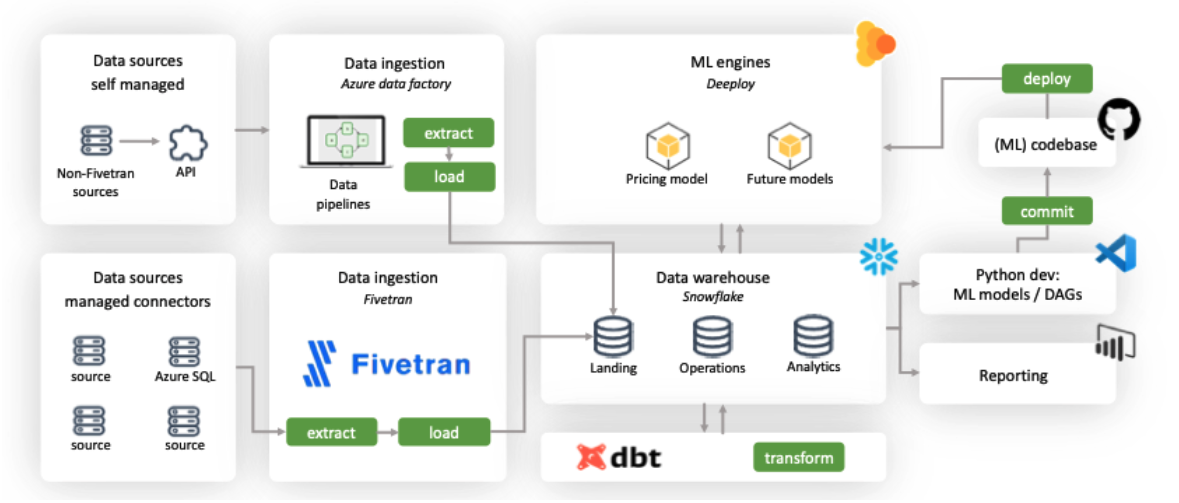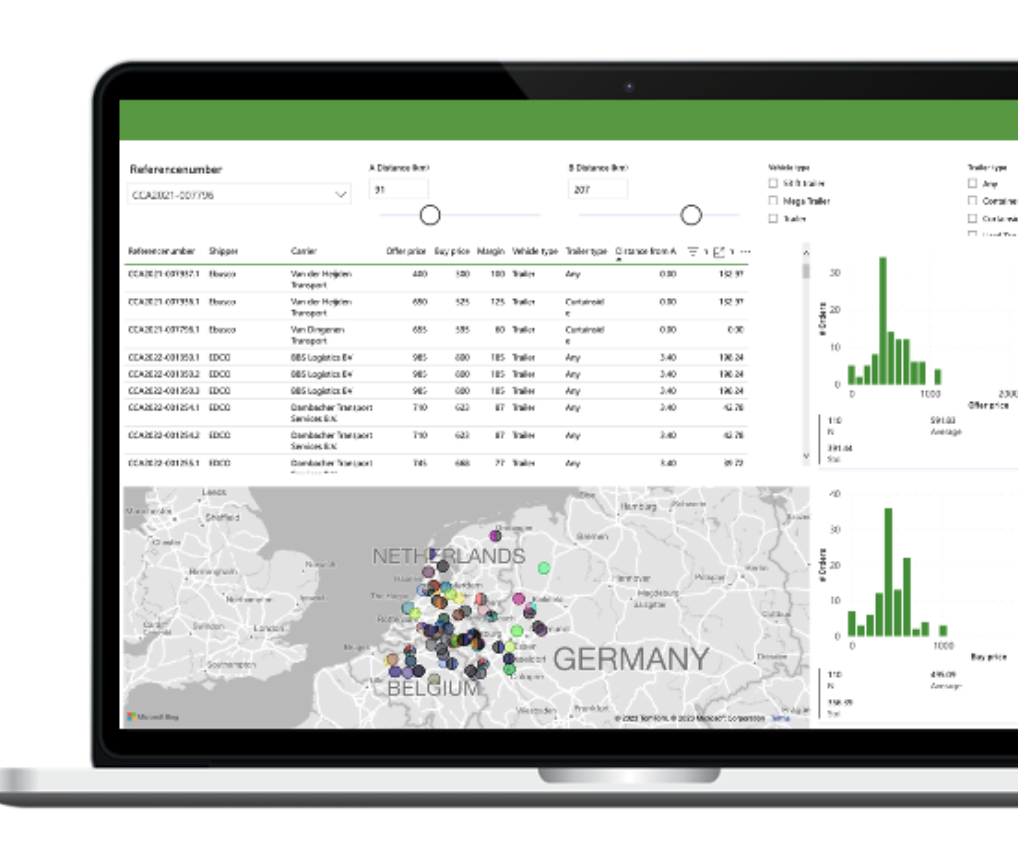CtrlChain: Developing a modern data platform for a fast growing tech scale-up

Matching supply and demand through optimized pricing
Context
CtrlChain is a Dutch scale-up focusing on digitalizing road transport. Their platform serves as a hub between shippers and carriers, helping shippers find the most efficient transportation for their goods and carriers to find the best matching loads. CtrlChain has the ambition to optimize logistics by maximizing the efficient use of available resources and, as a result, reduce environmental impact in the process. They aim to reach this ambition by leveraging data and machine learning (ML) models to automate decision-making. Resulting in an improved user experience and additional value in the market.

Challenges
At the start of the collaboration, CtrlChain had a well functioning platform built by their tech-heavy team, where transport demand met supply. However, their vision was to make the platform smarter to match supply and demand better and faster, throuh introducing Machine Learning. Additionally, they wanted to make better informed decisions through data and analytics. Fundamental was to stay in control of all historic data. Not only the data generated in their platform, but also internal systems like CRM and financial systems.
CtrlChain asked Enjins to help setting up their data & AI capability and to build and operationalize multiple ML use cases for their freight forwarding business as well as leveraging their data & analytics. However, the question was: where and how to start? Which use cases to prioritize, what data analytics platform to build, and which data and AI skills to hire to build the team?
This case gives an insight into CtrlChain’s data & AI journey and how they went from 0 to 100.
Approach

Step 1: Create a plan for development and prioritize the use cases
CtrlChain understood why data & AI are important to their business. However, the question was how to build data, analytics, and AI in a scalable manner that drives business value.
Before starting coding and building, CtrlChain and Enjins conducted a 4-week strategy period called the ML audit. This resulted into a plan that contained a thorough assessment of the current data setup, a blueprint of a modern data analytics platform, prioritization of use cases by assessing the business impact and technical feasibility, define the new positions for the data team, and create a roadmap that showed what activities are needed for realizing the use cases
Main Outcomes
- Don’t start with the highest impact use case. Instead, pick a use case that is feasible and have positive business impact. By doing so, CtrlChain can build the required fundaments along side the first ML use case. That was in this case: pricing spot quote.
- Develop a data analytics platform that can scale on the three axes: more data, easily streamlining analytics and deploy multiple machine learning models.
- Create initial dashboards to demonstrate value of data & analytics to the business.
- Hire a data team consisting of an analytics engineer, data engineer, and data scientist with support of a product owner. Especially the engineering skills are overlooked in the beginning, which will have a negative effect on future developments.
- By partnering the aforementioned goals can be achieved in 4 months
”Through our partnership with Enjins, we've developed a state-of-the-art Data Analytics Platform designed to rapidly convert data into invaluable business insights and ML algorithms.
Rick van ElkVP Technology
This collaborative effort, uniting our logistics expertise with Enjins' expertise in Machine Learning, has proven as a robust initiative to minimize wastage within the logistics sector.
Step 2: Co develop the data platform with pricing spot quote
As a follow-up from the ML audit Enjins and CtrlChain decided to co-develop the data platform and proof its value by bringing the first pricing model to production. In a 4 month period the following 3 components were built.
FTL spot pricing model
Much of the gains to be made in making the transport sector more efficient are in optimizing the spot market for Full Truck Loads (FTL). This is the market for non-recurring or ad-hoc transport requests. Matching these to the right carriers can avoid unnecessary empty return trips. Determining the right price for these requests is challenging, due to their unpredictable nature and dependance on seasonal traffic patterns.
Based on historical pricing data, the spot price model provides CtrlChain employees with a prediction on what price is likely for a particular route on a particular date. This helps in decisions of accepting offers from carriers, and providing prompt responses to retailers requesting a spot quote.
Data platform

The goal of a data analytics platform is to gather all historic data, easily build anayltics pipelines that can be served to the business and create an environment to build and deploy ML models.
The design of the platform was based on the following core principles:
- Make life easier not harder, choose tools with low infra maintenance and are easy to onboard new people on
- Host models as microservices to serve the models in different applications
- Separate your data in a three-layered schema (Landing, Operations, and Analytics) to combine best of bost worlds; re-usability and flexibility.
Dashboards
To serve insights and model predictions to the business, a dashboard was build. This create enthusiasm throughout the organization, fostering adoption of data driven decision making.
Steps
- Carrier manager clicks on order link
- Prefilled filters based on start & end location
- See average price for similar historical routes
Impact
- Carrier manager can better estimate the expected price for the shipper instead of “gut feeling”

Step 3: Partner to accelerate other use cases
With the data platform in place and the first model used in production, the next phase was to scale out. Adding more data, building more use cases, and maturing the platform. By collaborating we aim to speed up the development. The main milestones are
- Onboard the new hires onto the data analytics team and keep momentum from earlier phases.
- Develop new dashboards to better track route, company, and ML performance over time
- Deploy new ML use cases (mainly recommendation and pricing use cases) that improve matching supply and demand.
- Add new major data sources to the data platform that contain customer, shipment information, and marketing performance
- Extend the data platform with functions such as experiment tracking, CI/CD pipelines, ML retraining flow
Conclusion
In less than 12 months, CtrlChain has managed to build a fundament on all four elements: data, analytics, ML, and team. Thanks to the combination of all four elements, CtrlChain is creating business value and have set themselves up for scaling their data & AI capability and optimize logistics and reduce environmental impact further.
Throughout this data & AI journey, prioritization is key and a focus on engineering from day 1 helps to build a future-proof data analytics platform that scales with CtrlChain’s analytics and ML use cases needs.
Great to be part of such a rapid growing and innovative company.

 Follow us on LinkedIn!
Follow us on LinkedIn! Check out our Meetup group!
Check out our Meetup group!